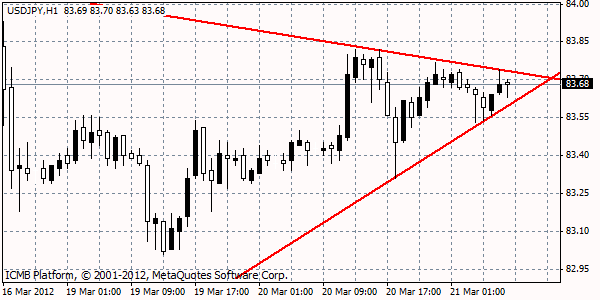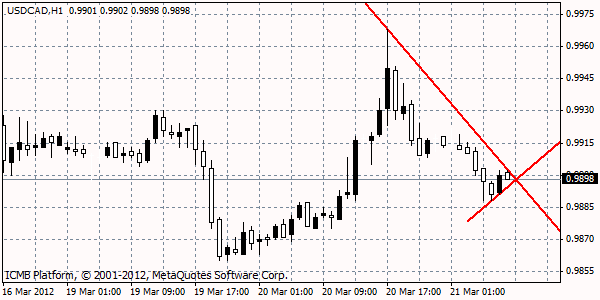9+ EUR/USD
The euro advanced against the dollar and reached a four-month high versus the yen after Greece won parliamentary approval for a new international bailout, boosting demand for the region’s assets. The 17-nation currency rose against most major peers before reports tomorrow forecast to show an expansion of services and factory output in Germany, Europe’s largest economy. The dollar weakened before Federal Reserve Chairman Ben S. Bernanke tells Congress that financial strains in Europe have eased, according to testimony prepared for delivery today. The euro rose 0.4 percent to $1.3280 as of 11:43 a.m. in Tokyo. The 17-nation currency climbed 0.3 percent to 111.02 yen and earlier touched 111.06, the most since Oct. 31. The yen added 0.1 percent to 83.60 per dollar. Greek Prime Minister Lucas Papademos won approval for a 130 billion-euro ($172 billion) aid package. A total of 213 lawmakers voted today in favor of the legislation and 79 against, Acting Parliament Speaker Grigoris Niotis said. Demand was also supported before the release of purchasing managers indexes tomorrow from London-based Markit Economics predicted to show German manufacturing and services growth accelerated. A measure of factory output climbed to 51 this month from 50.2 in February while a gauge of services rose to 53.1 from 52.8. EUR/USD" title="EUR/USD" width="911" height="662">
EUR/USD" title="EUR/USD" width="911" height="662">
GBP/USD
U.K. Chancellor of the Exchequer George Osborne will need to claw back about 5 billion pounds ($8billion) a year, largely from the wealthy, to fund giveaways he’s suggested will feature in his annual budget today. Osborne will have to raise more than 2.5 billion pounds a year if he cuts the top income-tax rate to 40 percent from 50 percent, a step sought by lawmakers from his Conservative Party. Increasing the starting point for paying income tax by 1,000 pounds to please the Liberal Democrats in the coalition would cost another 2 billion pounds, according to Treasury estimates. Measures to compensate some middle-income families for the loss of child-welfare payments might need 1 billion pounds. To pay for this, the rich are likely to be squeezed further; a clampdown on stamp-duty tax avoidance, a tax on more expensive houses and a further cut in tax relief on pension contributions all look possible. Osborne, who speaks to Parliament at 12:30 p.m. in London, is constrained by his commitment to keep Britain’s AAA credit rating. He told other ministers in Prime Minister David Cameron’s Cabinet during budget negotiations that he will not borrow more money to finance tax cuts. Earlier this month, Fitch Ratings added to warnings from Moody’s Investors Service that Britain’s top rating carries more than a 50 percent chance of a downgrade over the next two years. GBP/USD" title="GBP/USD" width="911" height="662">
GBP/USD" title="GBP/USD" width="911" height="662">
USD/JPY
Risk aversion is dominating markets right now, but that isn’t keeping the yen from heading lower. Instead of getting a boost as a safe haven currency, the Japanese yen remains lower against other majors. Right now risk aversion is high as lack of fresh and positive data leads investors to take profits and consider what might be next. Also contributing to the atmosphere of risk aversion is the fact that there are worries about Chinese demand. With time for reflection on the state of the Chinese economy, many investors are concerned that demand for commodities could weaken. This is also sending equities lower and boosting demand for the US dollar. Normally, this state of affairs would also mean a higher yen. The yen is seen as a stable currency, and one that traders can turn to during times of turmoil. However, the yen remains lower against other major currencies, even though the news and the data indicate that the yen should be in demand. USD/JPY" title="USD/JPY" width="911" height="662">
USD/JPY" title="USD/JPY" width="911" height="662">
USD/CAD
Canada’s dollar depreciated from almost a six-month high versus its U.S. counterpart as speculation China’s economy is slowing sapped demand for higher- yielding assets. The currency dropped against the greenback, which rose against the majority of its most-traded peers on demand for the safest of assets. U.S. equities declined and crude oil fell as Canadian benchmark government bonds gained for the first time in six days. Canada’s currency, nicknamed the loonie for the image of the waterfowl on the C$1 coin, weakened 0.5 percent to 99.15 cents per U.S. dollar at 5 p.m. in Toronto. It fell more than 1 percent earlier, the most since Dec. 12. One Canadian dollar buys $1.0085. The currency touched 98.42 cents on March 1, the strongest level since September. The loonie weakened against the euro and the Swiss franc after BHP Billiton Ltd (BHP) said China’s steel production is slowing. BHP, whose biggest customer is China, is re-evaluating spending plans amid slowing Chinese growth, the Australian Financial Review reported today, citing comments by Chairman Jacques Nasser to investors. USD/CAD" title="USD/CAD" width="911" height="662">
USD/CAD" title="USD/CAD" width="911" height="662">
- English (UK)
- English (India)
- English (Canada)
- English (Australia)
- English (South Africa)
- English (Philippines)
- English (Nigeria)
- Deutsch
- Español (España)
- Español (México)
- Français
- Italiano
- Nederlands
- Português (Portugal)
- Polski
- Português (Brasil)
- Русский
- Türkçe
- العربية
- Ελληνικά
- Svenska
- Suomi
- עברית
- 日本語
- 한국어
- 简体中文
- 繁體中文
- Bahasa Indonesia
- Bahasa Melayu
- ไทย
- Tiếng Việt
- हिंदी
Major Currency Pairs Analysis: March 21, 2012
Published 03/21/2012, 07:47 AM
Updated 04/25/2018, 04:40 AM
Major Currency Pairs Analysis: March 21, 2012
Latest comments
Loading next article…
Install Our App
Risk Disclosure: Trading in financial instruments and/or cryptocurrencies involves high risks including the risk of losing some, or all, of your investment amount, and may not be suitable for all investors. Prices of cryptocurrencies are extremely volatile and may be affected by external factors such as financial, regulatory or political events. Trading on margin increases the financial risks.
Before deciding to trade in financial instrument or cryptocurrencies you should be fully informed of the risks and costs associated with trading the financial markets, carefully consider your investment objectives, level of experience, and risk appetite, and seek professional advice where needed.
Fusion Media would like to remind you that the data contained in this website is not necessarily real-time nor accurate. The data and prices on the website are not necessarily provided by any market or exchange, but may be provided by market makers, and so prices may not be accurate and may differ from the actual price at any given market, meaning prices are indicative and not appropriate for trading purposes. Fusion Media and any provider of the data contained in this website will not accept liability for any loss or damage as a result of your trading, or your reliance on the information contained within this website.
It is prohibited to use, store, reproduce, display, modify, transmit or distribute the data contained in this website without the explicit prior written permission of Fusion Media and/or the data provider. All intellectual property rights are reserved by the providers and/or the exchange providing the data contained in this website.
Fusion Media may be compensated by the advertisers that appear on the website, based on your interaction with the advertisements or advertisers.
Before deciding to trade in financial instrument or cryptocurrencies you should be fully informed of the risks and costs associated with trading the financial markets, carefully consider your investment objectives, level of experience, and risk appetite, and seek professional advice where needed.
Fusion Media would like to remind you that the data contained in this website is not necessarily real-time nor accurate. The data and prices on the website are not necessarily provided by any market or exchange, but may be provided by market makers, and so prices may not be accurate and may differ from the actual price at any given market, meaning prices are indicative and not appropriate for trading purposes. Fusion Media and any provider of the data contained in this website will not accept liability for any loss or damage as a result of your trading, or your reliance on the information contained within this website.
It is prohibited to use, store, reproduce, display, modify, transmit or distribute the data contained in this website without the explicit prior written permission of Fusion Media and/or the data provider. All intellectual property rights are reserved by the providers and/or the exchange providing the data contained in this website.
Fusion Media may be compensated by the advertisers that appear on the website, based on your interaction with the advertisements or advertisers.
© 2007-2024 - Fusion Media Limited. All Rights Reserved.
